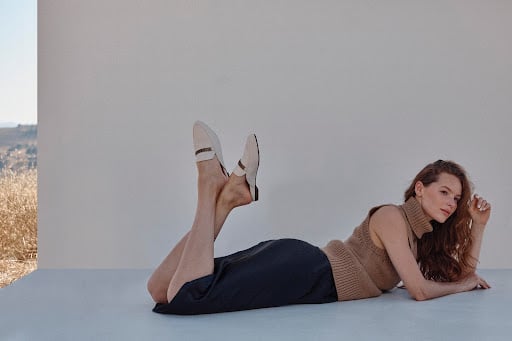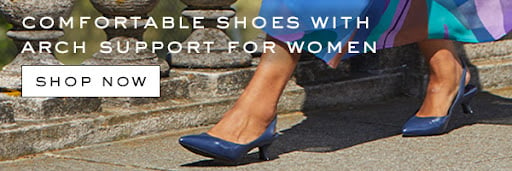
Put pack mules and Moscow mules out of your mind. This fashionable footwear style has nothing to do with donkeys or vodka cocktails.
Mules are a versatile shoe with a long and varied history. Even so, you might find yourself puzzled at the prospect of styling mules and incorporating them into your outfit rotation, or even asking—what is a mule shoe—in the first place.
Let this be your definitive introduction to a uniquely comfortable and stylish shoe, from its antiquarian origins to its contemporary usage.
An Introduction to Mule Shoes
What are mules shoes? Mules are defined as lightweight backless shoes, similar to slippers.
This definition of mules shoes, however, doesn’t quite capture their particular place in the footwear pantheon. Unlike slippers, mules are fully designed to be worn outside like any other shoe. Because of this, mules offer unparalleled comfort while still appearing elegant and elevated, making them one of the most favorable variations of support shoes for women.
Mules are a low-maintenance yet refined option to slip on in a hurry, complementing a wide range of outfits. After all, this style of shoe has maintained its popularity for thousands of years, making it one of the most historical additions to your closet.
The Ancient Roots of Mules
The odd name of mules comes from a Latin root. Ancient Roman Senators and members of the elite patrician class would wear red slipper-like shoes on the floor of the Senate and elsewhere.
The English world “mule” evolved over time from the Latin mulleus, meaning red.
The style of shoe itself dates back even further than the Roman Empire. Backless slides made from sisal or hemp, similar in shape and function to the modern mule, date back to prehistory.
The History and Evolution of Mule Shoes
Such an essential and universal shoe design is not limited to just one culture. The Metropolitan Museum of Art holds specimens of preserved mule shoes from Europe, America, Turkey, and Iran dating as far back as the 18th and 19th centuries., Many of these pieces are nearly works of art, intricately crafted from metal, silk, and other expensive materials—a far cry from the more primitive prehistoric mules.
The elite connotation held by mules in Ancient Rome persisted into early modern Europe. King Louis XIV of France was known to prefer these shoes and they took on a reputation as the chosen footwear of the renaissance elite across Europe. While the wealthy’s well-crafted mules are the best preserved in the historical record, there is evidence that all segments of society enjoyed mules’ comfort and ease-of-wearing.
As mules evolved, they often gained a high heel. By the 20th century, mules became more broadly known as a women’s shoe, and a glamorous, sultry, high-fashion women’s shoe at that.,
We’ve now reached the present, where mules are more versatile than ever. They still come in high-fashion varieties, but many are engineered for both comfort and style, striking a balance between the different benefits of the mule.
Distinctive Features of Mule Shoes
Mules are a distinctive category of shoe because of their simplicity: no laces, no backs, all class.
Here are a few of the things that set mules apart from all of their competitors in shoe space:
- Mules are laceless and slip-on. While it may not cost a huge amount of time, wrangling shoelaces or cramming your feet into tight flats are inconvenient and unnecessary when you could be on your way in an instant with mules. Finding the right fit also helps with this problem (discussed later).
- Mules are backless, which can relieve pressure other shoes might put on your heel. For those suffering from Achilles tendonitis or plantar fasciitis, the open-backed structure of a mule can be the most comfortable option.
- Mules are diverse. You can find open-toed and closed-toe mules. There are mules with high-heels, modest heels, or entirely flat soles. They come in a variety of materials and different price points. This is to be expected; hundreds of years of evolution and innovation are bound to spawn myriad varieties.
No matter your taste, occupation, or occasion, there will be a mule for you.
Exploring Different Styles of Mule Shoes
Mules cover a wide range of different shoe styles, all united by their backless slip-on nature. Some are closer to slippers, while others are ornate, appropriate for day-to-day wear and special occasions alike.
Below are a few of the most commonly encountered mule variations.
Leather Mules
The luxurious feel of leather suits the already-comfortable style of shoe. Leather also lets you wear these mules in weekday professional settings as well as in a more casual context. While mules are minimalistic by design, a tasteful ornamental detail can elevate your shoe choice to a bold statement.
Flat Mules
Among the most versatile shoes out there, flat mules can be worn in any situation that you’d wear a flat, with some even dubbing them “smart flats.” Flat mules work well in business and in life, with the added bonus of slip-on simplicity and a fashion-forward flair.
Stepped-Up Slippers
Who’s to say that slippers are for indoors only? And what are mule shoes if not an opportunity to mix the comfort of bedtime with high fashion. This style of mule features a plush lining that will keep your feet comfortable and happy even as you go about your day. All the style and visual sleekness of classic mules with the fuzzy feeling of slippers too.
High-Heeled Mules
A statement out of the 1950s or an episode of Sex and the City, the high-heeled mule is a surefire way to step up a glamorous outfit. This style of mule is more specific to a type of occasion than the previous styles, most often seen alongside dresses, gowns, and pantsuits.
Whichever style you choose to complement your outfit, you can be assured that the classic look and feel of mules will be the right choice.
Mule Shoes in Modern Fashion: Trends and Innovations
In contemporary fashion discourse, mules are known as a spring and summer shoe. Because you can wear them with or without socks, they let you bridge the gap between chillier early spring and the dog days of summer, when open-toed shoes are all the rage.
Maintaining and Caring for Your Mule Shoes
As noted, mules are an ancient shoe variety that’s been around for millennia. If you want to make sure your new pair of mules age as gracefully as the style itself, you can take a few key steps to keep them in tip-top shape.
- Keep your mules dry and out of direct sunlight. Heat and moisture can warp the shape of your shoes—important, since mules’ simple silhouette are a part of their charm.
- Remove small amounts of visible dirt and grime with a dry cotton cloth.
- If your shoes get especially dirty, you may need to apply a cleaning solution and buff out the stains with a horsehair (or synthetic) shoe brush. Patch test your cleaning product on a small area first to make sure it doesn’t cause any discoloration.
Mule maintenance doesn’t take too much time or effort. Even occasional shoe care will go a long way to keeping you on your feet in style for years to come. What are mule type shoes if not a wardrobe piece worth keeping pristine and in rotation.
Finding Your Perfect Fit: Sizing and Comfort in Mule Shoes
Wearing the right size shoe is always important, but especially so with mules. Because they lack a back, a mule’s snug yet comfortable fit is what keeps your foot from flopping out with each step. Here’s a few tips for ensuring you end up in a mule right for you.
- Make sure your foot is even with the back of the sole to make sure the length is correct.
- Signs your shoe is too big include rubbing pain or blisters on the front of your foot. If your shoe falls away from your foot with each step, you might need to go a size down.
- Signs your shoe is too small include tingling or numbness in your toes. This is caused by constriction in the front of the shoe and means you need to go up a half or full size. If your heel hangs over the sole of the shoe in the back, that would also indicate a small fit.
Wear your shoes in by keeping them on for only a few hours at a time when you first purchase them. By a week into owning them, you should either be in love with the snug fit or realize you need to adjust your sizing.
Make the Most of Mules with Vionic
If the comfort and classic style of mules appeal to your shoe-shopping sensibilities, check out Vionic’s selection of elegant footwear.
Looking for luxury in leather? Our Starling Mule is the perfect work shoe or weekend wear.
Seeking a sort-of slipper that still stuns? Leave the house in unparalleled comfort each morning in the Arlette Mule.
Or for an in-between pick, our Georgie Mule is a suede option that offers the best of both of the above shoes.
All of these shoes feature our patented Vio-Motion technology, meaning your arches will be supported and your feet cushioned in any mule you choose.
Sources:
- Fashion Institute of Technology. Mule | Fashion History Timeline. https://fashionhistory.fitnyc.edu/mule/
- The Metropolitan Museum of Art. Mules, European, early 18th century. https://www.metmuseum.org/art/collection/search/156202?sortBy=Relevance&deptids=62%7c8&ft=women+shoes&offset=20&rpp=20&pos=32
- The Metropolitan Museum of Art. Mules, late 19th–early 20th century. https://www.metmuseum.org/art/collection/search/88856?sortBy=Relevance&what=Mules&ft=*&offset=0&rpp=20&pos=8
- The Metropolitan Museum of Art. Mules, American, ca. 1960. https://www.metmuseum.org/art/collection/search/156282?sortBy=Relevance&deptids=62%7c8&ft=women+mules&offset=0&rpp=20&pos=2
- The Metropolitan Museum of Art. Mules, American, 1950–1959. https://www.metmuseum.org/art/collection/search/156263?sortBy=Relevance&deptids=62%7c8&ft=marabou&offset=0&rpp=20&pos=2
- The New York Times. How to Clean Leather and Suede Shoes. https://www.nytimes.com/wirecutter/guides/how-to-clean-leather-suede-shoes/


Leave a Reply